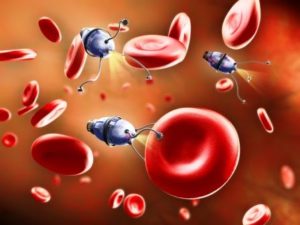 Robotics in medicine has been used for quite a while now. A good example of this is the surgical robots that revolutionized minimally-invasive surgery. A relatively new field of research is the combination of material science and biomedical science, making it possible to implement medical robotics at the micro- and nanoscale. Miniature robots that can perform various precision tasks inside the body are now possible due to these new technologies.
Robotics in medicine has been used for quite a while now. A good example of this is the surgical robots that revolutionized minimally-invasive surgery. A relatively new field of research is the combination of material science and biomedical science, making it possible to implement medical robotics at the micro- and nanoscale. Miniature robots that can perform various precision tasks inside the body are now possible due to these new technologies.
Microbots, nanobots and what they can do
These miniature devices are called micro- or nanobots. But these aren’t anything like the image of robots we have in our head! They aren’t tiny machines set to do just any task, but instead are tiny particles capable of performing a few specific actions involving movement, sensing and execution of a simple programmed task.
These nanobots exist in an entirely different world than what we live in! This is because they’re subject to different forces at a molecular level. Designing devices on this scale brings some major challenges, however. For one, movement occurs in a significantly different way compared to macro scale. These micro- and nanoscale devices operate in environments with low-Reynolds numbers. This means that they have to propel themselves in a fluid-like substance without any forces to slow them down (inertia). Second, these micro- and nanobots are constantly bombarded by atoms and molecules moving around; a phenomenon called Brownian motion. Of course, the above-described processes are present all around us, but we aren’t tiny so we don’t notice them. Both these limitations significantly hinder the ‘normal’ movement of these bots and pose some real obstacles to overcome. Another problem would be powering these nanobots, since conventional solutions such as batteries cannot be scaled down to this size.
Nevertheless, research has made it possible to create these devices on micro- and nanoscale, allowing them to move and execute simple tasks. While they mostly have been tested in vitro using non-biocompatible fuel, which would be toxic in animals and humans, the possibilities are still promising. Once movement is achievable using biocompatible fuel (or fuel that can be used inside the body), these nanobots can be allowed to travel the bloodstream and enter tissues. Different strategies are possible, and at this time, in vivo studies are already taking place using synthetic motors powered by biological fluids, like gastric acid and water.
Possibilities in medicine
Nanobots powered by external sources such as ultrasound or magnetic fields are also being investigated. This last example could, for instance, be used to guide specific substances to the correct place from outside the body. This way, drugs attached to bacteria guided by a magnetic field to target oxygen-deprived regions of tumours can be possible! Such areas are normally highly resistant to therapies since no blood flow is present.
Scientists have already tried using components already found inside the human body to help with specific tasks. Next to bacteria, red blood cells able to absorb toxins or nanomotors were proven to be successful in vitro. These are usually built from enzymes powered by glucose or urea.
Building nanobots this way can allow for promising medical techniques in the future. An example is the application of such nanobots in precision surgery using tiny gripping machines to bring back tissue to the surface, leaving only a puncture the size of a needle.
Current diagnostic tests can also be highly improved. These tiny nanobots can work to sense toxins or other substances and bind them, with or without receptors, and can even detoxify them at the same time. Right now, the most promising application is the delivery of drugs at specific target tissues. By using the body’s natural delivery system–the blood circulation–drugs can be delivered rapidly and at specific sites, such as tumour tissue. This would also yield less side effects and be more effective, since only the target tissue receives the drug.
More research needed
Despite all the progress, a lot more research is needed to be able to implement these applications in humans. Unfortunately, research is slow due to the lack of materials on hand. A lot of effort and funding is needed to synthesize the required amount of nanobots to study for executing the right tasks.
Additionally, these bots are not yet able to act autonomously. They still need human interference to direct them to continuously perform their tasks. Ideally, we’d like robots that keep on performing their programmed task with very minimal interference.
There may still be various obstacles to overcome, but we’re on the right track! This means that having micro- and nanobots to help with diagnostic, drug delivery, and a wide range of other medical functions may be a reality in the near future!
References
- https://singularityhub.com/2017/03/07/4-ways-scientists-hope-nanobots-will-make-you-healthier/
- http://www.understandingnano.com/medicine.html
- https://www.theatlantic.com/technology/archive/2015/08/nanobot-treatment-doctors-cancer/400613/





